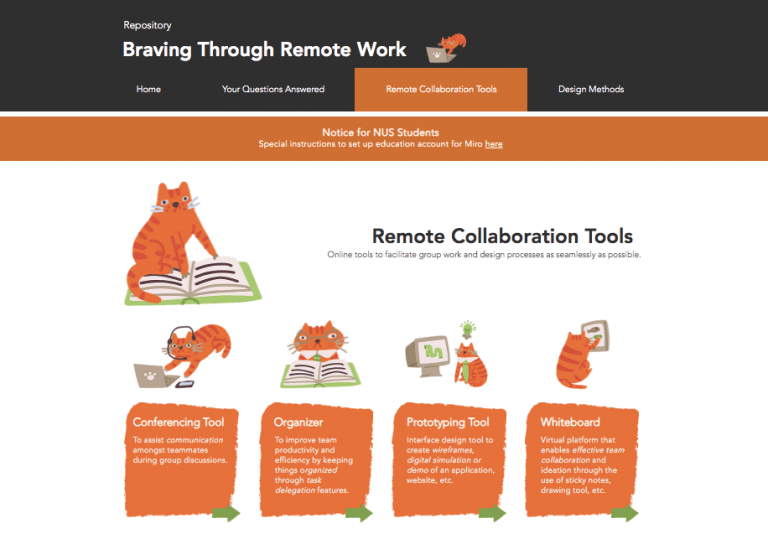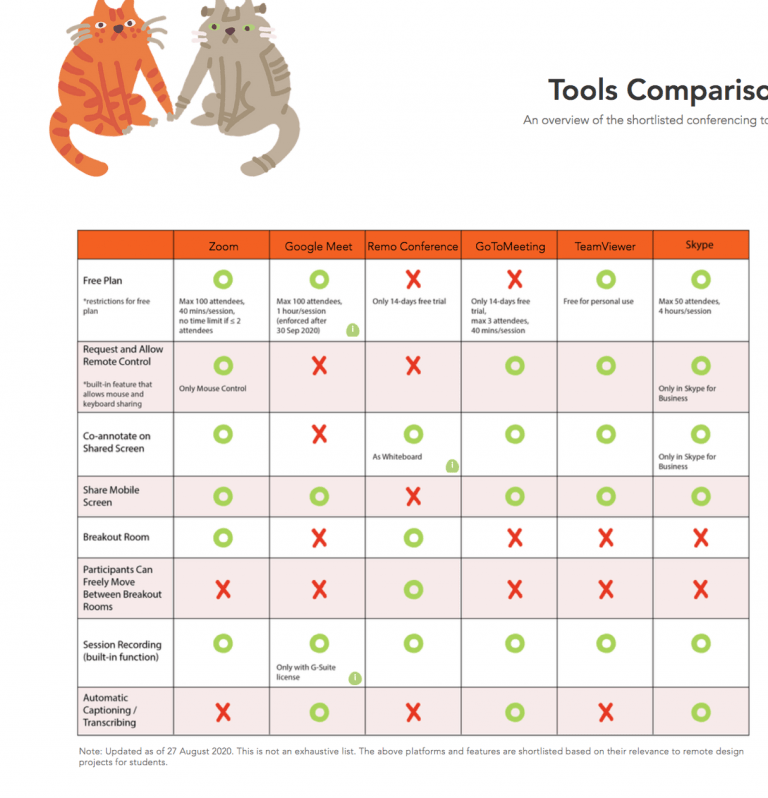Jung-Joo LEE
Division of Industrial Design (DID), School of Design and Environment (SDE)
Jung Joo discusses her team’s experience of developing an online repository of curated remote collaboration and design tools to help DID students select appropriate tools for their own learning needs during the COVID-19 pandemic.

Lee, J. J. (2021, Oct 26). Braving through remote design work: Developing an online repository of remote design tools for design students. Teaching Connections. https://blog.nus.edu.sg/teachingconnections/2021/10/26/braving-through-remote-design-work-developing-an-online-repository-of-remote-design-tools-for-design-students/.
“How could we learn about users’ emotions when we cannot meet them?”
– A question raised by a DID student during the Circuit Breaker
Among the numerous challenges the pandemic has brought to education, design students faced a particularly serious and discipline-specific one—no interaction with the people for whom they are designing. I have been teaching Human-Centred Design and Service Design to undergraduate design students in the Division of Industrial Design (DID) for many years. One of the key learning objectives there is to learn how to build an empathic understanding of people who the students are designing for (we often call them “users” in design). In the Human-Centred Design process, students by default have to go out there, mingle and spend some time with their users, so that they can genuinely understand users’ pain points and future needs. User groups vary, depending on the types of design projects. In my previous teaching experiences, the students designed for migrant workers, children from vulnerable families, the elderly and so on, and part of the learning process involved visiting migrant workers’ dormitories, children’s homes, and nursing homes.

(Photo credit: Lim Xin Yuan).
Since the spring of 2020, the pandemic situation has put a full stop on those essential design-related activities. Design communities globally started responding to this challenge and introduced “remote design research”, using various online platforms and remote design tools that could facilitate collaboration and user research in a remote manner. Within just a few months, there was a flood of introductions to remote collaboration tools (e.g. Zoom, Google Meet, Microsoft Teams, Miro, Mural etc.), and lectures and articles about how to conduct remote user research and remote design activities. The problem, however, was that the information and resources were provided in a very disorganised and scattered manner, from different sources with different levels of credibility.
To help our design students navigate this flood of information, my team from Service Design Lab Singapore developed a student-centric online repository that curates information about remote collaboration tools and remote design methods (Figure 2).

The aim was for students to have an overview of various alternatives and become adept at choosing the right tools for their own needs. We took a very human-centred design approach to develop the repository. We conducted a survey with students and faculty members in DID to find out their key challenges and needs. Based on the findings, the online repository has been designed in a student-centric way, with following features (Figures 3 and 4).


Since its launch in July 2020, this online repository has become a handy self-help resource which design students refer to for various projects. The online repository was shared with all DID students via the mailing list and featured in DID’s website for their easy access. For the past year, our design students quickly picked up the various remote design tools and developed their own skills for remote user research. For example, they learned to conduct a co-creation workshop with their users by combining Zoom and the Miro board (Figure 5). They also conducted a prototyping test by combining Zoom with a digital prototyping tool called Figma.

Going beyond what the online repository offers as a source of information, the students learned how to turn the challenges they encountered into opportunities by creatively adapting to the constraints. They developed their own tactics to create rapport with their users in an online environment, for example, by introducing virtual ice-breaking activities.
This was what we aimed for eventually. This kind of online repository serves as a “scaffold” (Wood et al., 1976) for students to build their confidence in choosing a right tool for their own needs, and develop a sensitivity towards evaluating various tools. Through this, students can discover new tools and even develop new methods that fit their needs, beyond what this repository offers. While the current repository focuses on the curation of tools, we observed that students benefited a lot from the actual case studies. Moving forward, the online repository should include more cases that illustrate how varied remote tools can be used for specific design challenges. In addition, the repository should be a living thing to remain up-to-date to feature new and upcoming digital tools, as the trend of digital tools changes so fast.
 |
Jung-Joo (JJ) LEE is an Assistant Professor and Deputy Head (Research) at the Division of Industrial Design (DID), NUS. She teaches and researches Service Design and its contribution to public administration, business innovation and digital transformation. She also heads Service Design Lab Singapore. JJ can be reached at jjlee@nus.edu.sg. |
Acknowledgements
Special thanks to Pang Shi Jie and Christine Yap for the design, development and dissemination of the online repository.
Reference
Wood, D. J., Bruner, J. S., & Ross, G. (1976). The role of tutoring in problem solving. Journal of Child Psychiatry and Psychology, 17(2), 89–100. https://doi.org/10.1111/j.1469-7610.1976.tb00381.x

